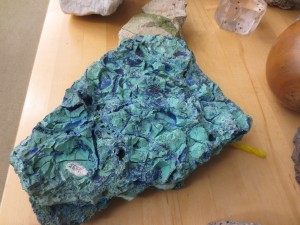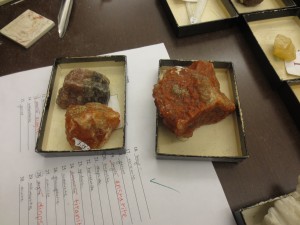Contrary to popular belief, not all rocks are the same; in fact, they have a diverse set of origins, compositions, structures, and properties, all of which can be related back to their mineral make. This of course renders mineralogy, which is exactly what it sounds like, an important component of any geologist’s set of mental tools for conducting field work and research. Now there are a wide array of methods with which you can test different samples in search of a positive identification; streak tests, color classification, reaction with acidic solutions, and hardness tests are all basic field tests. And while all of these tests are fairly reliable in most situations, I would argue that there is actually an equally useful and much more interesting method which is also used on occasion by geologists: licking rocks. Yes, you read that correctly: licking rocks. Perhaps you are a bit confused as to why / how licking rocks is actually a useful scientific technique, so allow me to elaborate.

Let’s take the chrysocolla featured on the left for example. Chrysocolla is a hydrated silicate mineral with the very complicated formula of (Cu,Al)2H2Si2O5(OH)4·nH2O. You might be tempted to say that the blue color (derived from the copper) is a defining diagnostic feature. While it certainly makes it easier to narrow down the range of possibilities as compared to translucent minerals, there are many other blue minerals. For example, consider azurite, Cu3(CO3)2(OH)2. Azurite is another blue copper-colored mineral, and if you had never seen either sample, you wouldn’t know that azurite is normally a much deeper blue than chrysocolla, the latter of which is more of a turquoise. Now to complicate things further, let’s add in a sample of actual mineral turquoise CuAl6(PO4)4(OH)8·4H2O, which is actually the color turquoise, and it becomes a bit stickier to differentiate them. Until you lick them. Chrysocolla sticks to your tongue, while the other two do not. If you don’t want to lick a rock because that seems socially unacceptable, you can alternatively lick your finger and then stick it on the rock with the same effect. This is an acceptable form of rock-licking as well, although arguably far less enjoyable. While you probably couldn’t publish any paper involving chrysocolla with only a lick test as your positive identification, it’s admittedly a pretty cool parlor trick that will work with many other dry, porous minerals and rocks.
Now, finding that rocks stick to your tongue is not the only value of the lick test; after all, your tongue’s real purpose isn’t to test textures on different things, but rather to taste. Which is another diagnostic feature of some minerals. Allow me to introduce halite (NaCl), which for those who have taken (and remember) basic chemistry, has the same formula as table salt.

And indeed, if you lick a halite crystal, which is more commonly known as rock salt, it tastes quite salty (this is why some animals, including the family dog, may lick rocks). However, here’s where the lick test gets dicey; allow me to now introduce sylvite (KCl). If we examine the picture on the right, we have sylvite and halite. Some basic crystal chemistry will tell you that the two are very similar in composition and size; just swap the sodium (Na, 1+ charge) and the potassium (K, 1+ charge) and you have our two minerals. And if you look at the picture, the larger red sample looks quite similar to the front sample of the box containing two minerals. So how does one distinguish between the two? According to my textbook (Introduction to Mineralogy by William Nesse), sylvite “closely resembles halite but has a more bitter taste.” This is of course the most ridiculous “scientific” description that I’ve ever heard of because both of them taste equally salty. I am also fairly confident that neither I nor the average reader would describe anything salty as being bitter; you’d describe it as salty! Now it might seem that I’ve contradicted myself by denting the argument that licking rocks is a valid and useful technique, but consider this: there are over 4,600 recognized minerals and over 4,900 known minerals in the world. Many of them will have the same streak, the same color, the same hardness, and the same reaction with acid, and if you had no idea how to narrow down your options to a few dozen minerals, you could spend several days comparing your unknown sample to hundreds of thin sections and XRD graphs in search of an identification. Knowing that your rock is salty (and thus part of the halide group) cuts down your options to a couple dozen, which is narrow enough to allow for a reasonable amount of more complicated analysis in order to obtain a positive identification.
Let’s return to when rocks stuck to your tongue when you licked them. It turns out that there’s another subcategory in which tongue-sticking rocks justify licking a random rock you found on the ground, one which I think the reader will find the most persuasive: licking rocks will help you find fossils. If you read my post from last week, you read all about my fossil-hunting adventures. The first test to see if something was a fossil or just petrified wood? We licked it. Fossils, by virtue of having the porous structure of bone preserved in the mineral structures, will also commonly stick to your tongue, and when you’re lacking the resources of laboratory technology to conduct more detailed tests, the lick test quickly becomes your best friend (as well as a way to impress people). More importantly for you, the reader, this now enables you to do a rudimentary test if you should ever come across a potential fossil. Perhaps you think that only paleontologists can find fossils, but in reality, many of the fossils that paleontologists work on are actually first found by everyday people like cattle ranchers, young children, and construction workers. In other words, that could be you! If I hadn’t convinced you before of the merits of rock-licking, I think the prospect of being able to positively identify a T-rex fossil must appeal to at least some of you readers.
In conclusion, I hope to, at the very least, provided some compelling reasons to show that I’m not completely crazy for licking rocks, and perhaps even convinced you to give this a try yourself (discretion advised). Perhaps I’ve even inspired you to do a little personal research or to take a class in mineralogy to find out more. Realistically, you can’t use the lick test for everything, and you shouldn’t go around licking every rock to try it out (I certainly don’t), but it definitely has been useful for me, and if you do it for no other reason, it can impress the people that you’re rockhounding with. Just make sure that you don’t show this trick to your kids, lest they become like me and develop a passion for walking around the desert licking interesting rocks.
